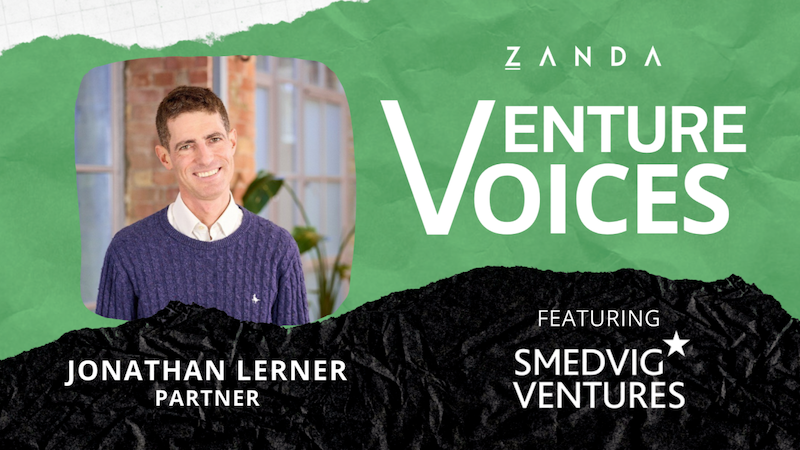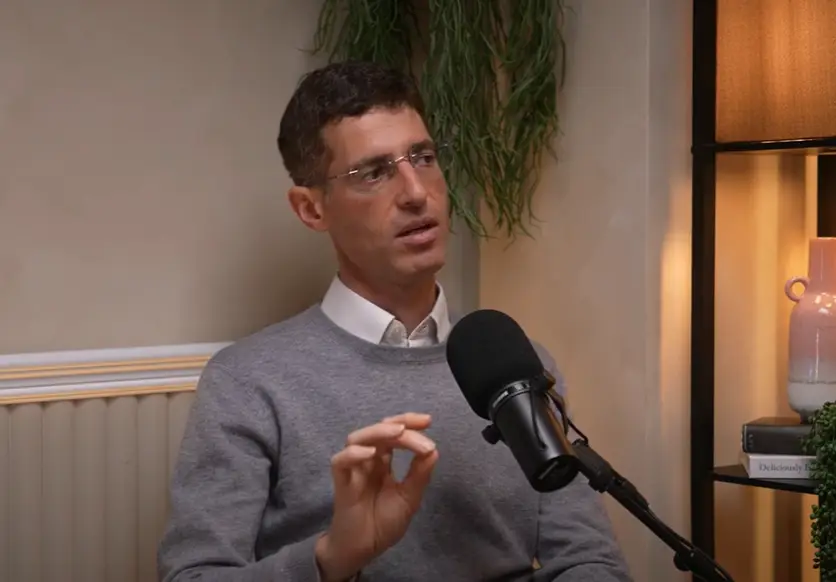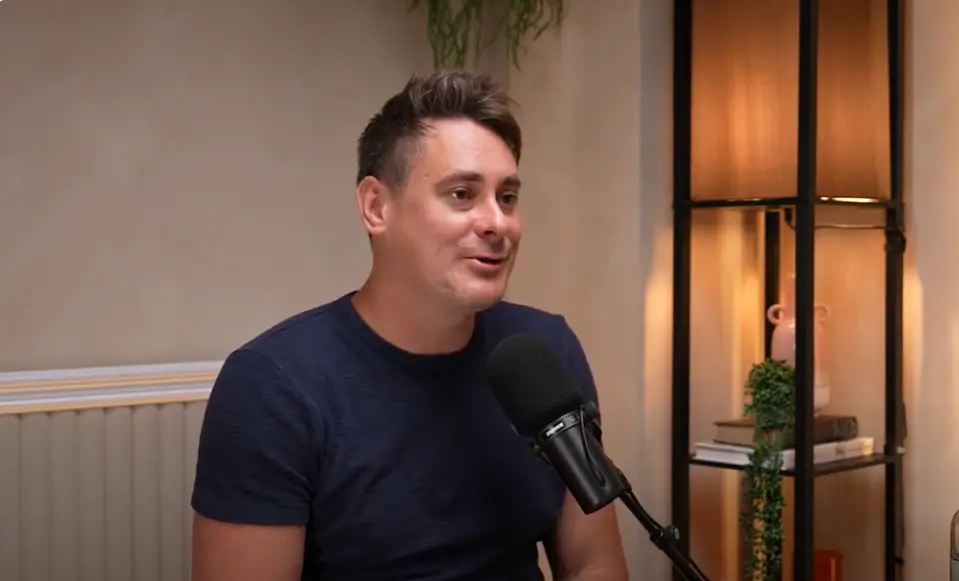
Venture Voices | Mountside Ventures
30 Jul, 202518 minutes
In a market where capital is cautious and competition fierce, Jon Steinberg has built a business helping startups cut through the noise. As Co-founder of Mountside Ventures, he works with founders across Europe to run better processes, close better rounds, and raise with conviction. He joins us on Venture Voices to share what he’s learned.
In this conversation, Jon reflects on his path from PwC’s early-stage advisory team to launching Mountside Ventures, and how an entrepreneurial mindset shaped the firm’s founder-first model. We unpack what a great Series A or B raise looks like in 2025, the growing emphasis on capital efficiency, and why drip-feeding a fundraise can seriously weaken your position. Jon also shares insights on the evolving role of CFOs post-raise, the strategic use of venture debt, and where AI is genuinely improving outcomes, beyond the hype.
Don’t have time to read the entire discussion, watch the full discussion on our youtube channel or listen on spotify.
Jon, you’ve built a business that now helps other startups raise and scale but what did your journey look like to get here?
I’ve always wanted to be an entrepreneur, but early on I wasn’t sure what shape that would take. I studied pure mathematics at university and started my career at Intel, but realised I wanted to build a stronger foundation in finance, so I moved to London and joined PwC.
I went through the PwC graduate scheme, became a chartered accountant, and then moved into the advisory practice, where I met my two co-founders. We shared a real interest in working with early-stage companies and eventually launched an internal team focused on helping startups raise capital, which became the PwC Raise programme.
It was a great learning experience. We got to see how founders approached fundraising, what made a compelling narrative, and how to build real momentum in a round. But over time, we realised our approach, fast-moving, founder-first, and hands-on, didn’t fully align with PwC’s wider strategic direction.
So, we made the leap and set up Mountside Ventures. The goal was simple: to build a startup that helps other startups raise better, more confidently, and more efficiently, especially at that critical Series A and B stage where the stakes are much higher.
In establishing Mountside Ventures, what was the gap in the ecosystem you were looking to plug?
When we looked at the market, we saw a real lack of qualified, professional advice at the very early stage. And by early, I mean Series A, not pre-seed or seed. It is that critical inflection point where fundraising shifts from being about founder vision and storytelling to being grounded in data, financials, and a well-run process.
At Series A, you need to clearly define all the key components of your value proposition, things you rarely have to think about at pre-seed or seed stage. We chose to focus on Series A because it is arguably the hardest round a founder will go through. It is where the biggest drop-off happens: a lot of companies get seed funding, but far fewer make it to Series A. Then, Series A to Series B is usually a smoother journey, though that also depends on how you define Series B.
Since launching, we have closed around 55 to 60 institutional deals at that stage. As we built our brand and gained trust from both founders and investors, we found ourselves being referred to more companies, often by investors we had worked with at the seed stage who wanted support for their portfolio companies at Series A.
Over the past 12 months, we have naturally transitioned into the Series B market and has become my main focus,the analytical, structured approach plays to our strengths, so it is a natural next step for us. If Series A is half art, half science, then Series B is more like a quarter art and three quarters science.
Can you unpack what that shift means in terms of what investors are looking for and how founders need to prepare?
At Series A, you're typically extrapolating from a small number of proof points. Many B2B SaaS companies focussing on enterprise / mid-market raise at this stage with just five to ten clients and around £1 million in ARR.
If you’re selling to enterprises, those clients often have different contract terms, timelines, and ACVs, even if the value delivered is similar. So you’re working with a limited dataset to justify the broader market opportunity.
The Series A narrative is usually along the lines of: “We’ve sold to an insurance company, a bank, and an asset manager. Based on that, we believe we’ve identified our ideal customer profile, and we want to double down on that segment.” It’s a bet, based on early indicators.
By Series B, that hypothesis needs to be proven. Your ICP should be clearly defined, with a track record showing you’ve tested multiple segments and identified the one that scales best.
The focus shifts from experimentation to execution. At Series A, investors are still taking product and market risk. At Series B, those risks should be de-risked. The only remaining risk should be go-to-market execution.
What are the main things founders or CFOs are getting wrong with their fundraise in 2025, and how are you helping them get back on track?
The main challenge founders are facing right now is that the VC ecosystem is still quite sheepish when it comes to deploying capital. As a side note, we also run the Emerging VC Program, where, just like we do with founders, we support high-potential GPs in accelerating their fundraises through our network of limited partners and family offices. We’ve had around 500 applications from GPs looking to raise a fund but struggling to do so. From that, we filtered down to the top 20 to bring onto our program. The fact that so many funds are struggling to raise capital (note – not the ones on our programme, they’re all doing great) means there is a smaller pool of capital available to deploy into companies, and that gives founders less choice.
We’re also seeing a consolidation of LP capital into a small number of large funds. There are mixed opinions about that, but my view is that more choice is better; A larger number of smaller funds at the early-stage is healthier for the startup ecosystem, it creates more competition on terms, faster processes, and more diversity in investor backgrounds and thinking.
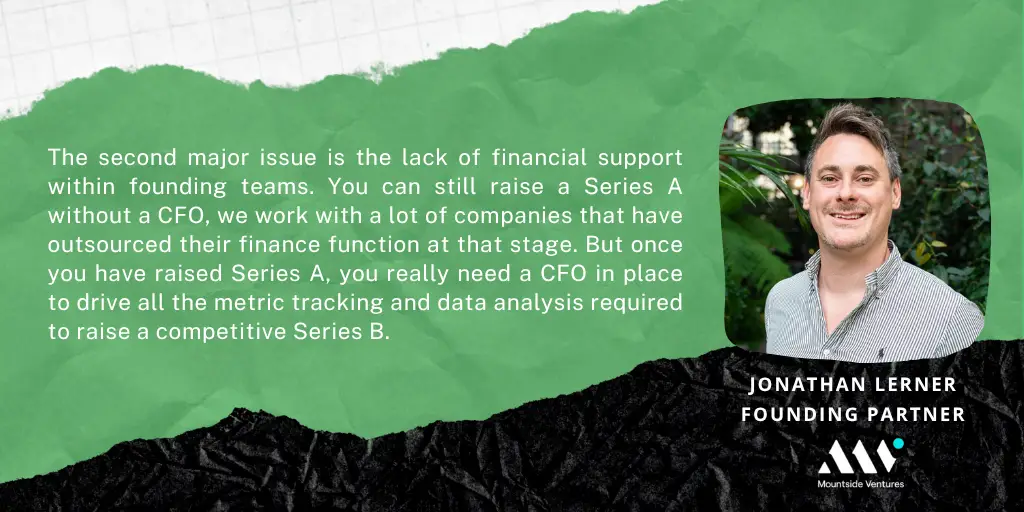
We are often going back retrospectively with our growth-stage clients to help them prepare financial data. That includes things like cohort analysis, gross revenue retention, net revenue retention, and how your unit economics will scale over time. You also need a detailed use-of-funds plan that ties directly into your product roadmap and more recently, that includes how you are going to use AI. Not necessarily to build your own AI, but to drive efficiency, competitiveness, and ultimately improve your speed and performance as a business.
When it comes to Series B, where data becomes even more critical, how important is net revenue retention and upsell as part of the picture? Would you say it's one of the top three metrics?
When I first started working in venture, NRR and GRR were the kinds of metrics you’d read about in books, but no one really talked about them or did much due diligence on them. That’s changed completely. Now, they’re probably the key value indicators we focus on, especially when deciding whether or not to take on a client.
We have internal guardrails. If a company has gross revenue retention (GRR) below 80% or net revenue retention (NRR) below 100%, we dig into that. We’ll ask questions and try to understand what’s behind the numbers, how sticky the product is, and whether there’s any pricing pressure. It’s about defensibility in the market. We’ll look into correlations like: if the company raises prices, how does that affect churn or margins?
We’ve worked with some fantastic CFOs who can demonstrate that they’ve increased prices across their client base and that the gains from those increases outweigh the churn. That’s what I’d consider gold standard, when a CFO can show that clearly through solid analytics and data.
Other than GRR and NRR, what other metrics do you really focus on at Series A or Series B?
Sales efficiency is something we look at closely, especially for companies heading into a Series B. One of the deals I worked on recently was heavily influenced by this metric, and I was really impressed by how the investor approached it.
Specifically, we looked at ramp-up time to quota across the sales team. At that point, the company had around eight sales reps in place. We examined how long it took them to ramp up, what their quotas were, and the ratio of ARR generated per sales rep versus their total compensation. If you can show a 2.5 to 3:1 ratio, excluding the founder or CRO from that analysis, that’s a strong indicator. It shows that the sales engine is working independently and can scale.
When a sales rep, over a 6 to 12 month period, is bringing in a multiple of their comp, it signals that go-to-market risk is starting to diminish. You can then make a credible case that, with eight performing sales reps, adding another 10 should produce similar results. That’s a powerful narrative for capital deployment over the next two years.
For seed-stage businesses approaching Series A, the founder is usually still leading the fundraise. They might have a fractional CFO, but many don’t. How do you think a founder’s background or personality affects their ability to raise successfully?
This is a really interesting topic because my two co-founders actually have very different views from me on this. We often come together, debate it, and agree to disagree. For me, the ideal founder to work with at Series A is someone who is direct, to the point, no fluff. They give it to you straight and are willing to flex their schedule to meet the demands of raising capital.
I genuinely like it when a founder pings me on WhatsApp at 11 p.m. with a question or update. That level of responsiveness, and the ability to address issues in real time rather than waiting for a scheduled check-in, is something I really value. It shows urgency and partnership.
As advisors, it is important for us to be collaborative and integrated with the team. I like being treated as an extension of the company, joining management meetings, having input on what we’re seeing in the market, and helping connect that insight to strategic decisions. Those two things are deeply linked, and the best outcomes happen when we can operate as thought partners.

Founders really need a strong team around them to free up the time and headspace needed for a fundraise.
Especially now it is taking longer than it used to! Our typical Series A timeline has extended from about three months to four and a half months. For Series B, it is now around six months. That’s quite a shift from when we first started the company. The first institutional deal we advised on, back in late 2020, closed in just seven weeks from start to finish. That was during the post-COVID boom, late 2020 through early 2022, when everything was moving faster. I’d say fundraises were often one to two months quicker during that period, sometimes even more.
Things have definitely stabilised now, and one of the key reasons is the lengthening of the period between term sheet and close. What used to be a 30-day due diligence window has now become 60 days in many cases. That’s written into the term sheet itself, so when you sign, you’re committing to another two months before funds are transferred.
One of the reasons for this shift is that investors want more time to validate pipeline quality. They’re not just taking your word for it anymore, they want to see those key contracts actually signed before closing the deal. So even when everything else is agreed and papered, the round can stall while everyone waits on a single deal to be finalised. That delay gives investors additional data points, not just around sales conversion, but also insight into how the company is operating. They might want to see updated management reports, customer metrics, or just observe how effectively the team runs the business over that extra 30 to 60 days. It’s a more cautious, data-driven approach than we were seeing a few years ago.
Is there an ideal number of term sheets to have midway through a fundraise? And do you have a sense of conversion?
We optimise our process around securing three term sheets. That tends to be the sweet spot. Everyone talks about how to negotiate a term sheet and what terms to push on or let go but the truth is, the most meaningful leverage comes when you have multiple investors at the same stage who all want to do the deal. When an investor issues a term sheet, they’ve put their name to it internally. So competition really does matter.
In one round we worked on last year, the first term sheet came in at a $35 million pre-money valuation. Then a second investor offered $55 million. Finally, a third came in at $60 million. But even though $60 million was the best valuation, the founders went with the $55 million offer. Why? Because that investor had been engaged in the process much earlier, had done the work, built the relationship, and shown real belief in the business from the start. The latecomer simply hadn’t done that. For the founders, the extra $5 million wasn't worth restarting the relationship.
That’s why we always advise investors to lead with the best offer they’re realistically willing to make. If you hold back and come in late with something only marginally better, you risk being disqualified simply because the founder doesn’t feel the same connection or commitment. Meeting the founder early, understanding their vision, and showing a desire to be collaborative from the outset, that makes a big difference. It’s not just about valuation. It also signals a lower completion risk. Founders want to know you’re serious and ready to partner with them, not just chasing the numbers at the last minute.
How do you turn a founder’s rough financial model into something investment-ready, the polished, glossy story?
If I’m being totally honest, we used to take clients’ existing models and try to turn them into fundraising-ready versions. We don’t really do that anymore. Now, we usually throw the model out and start again from scratch. Even when a model looks about 70 to 80 percent there, we’ve found that trying to fix it ends up costing more time than it saves. The time you think you save by tweaking an existing model is quickly lost once you're actually in the market.
We handle most of the financial due diligence questions directly, we carry the backpack, so to speak. When a founder has met an investor, sold the dream, and built a great initial relationship in those early calls, what comes next is a long list of detailed financial questions. That’s where we come in. 
After a Series A raise, what should a founder focus on in the first six months?
Where we see founders go wrong is usually in two areas: rushing key hires and overspending on marketing. For example, if your financial model says you need 10 engineers in the first six months, but you only get to six, that’s almost always fine from an investor perspective. It’s much better to hire the right people than to hit a headcount target just for the sake of it.
The other common misstep is deploying large marketing budgets before the product is truly ready. Founders feel pressure to show traction, but if you're still working through core product development, that spend rarely delivers meaningful return. That doesn’t mean you shouldn’t test marketing early, just like you're testing and iterating the product, you should be doing the same with go-to-market. But it needs to be measured. Spending too much, too fast, without clear ROI can lead to cash burn issues, which puts you into bridge round territory 12 to 18 months later.
You might hit £3 million ARR instead of £5 million, and while growing from £1 to £3 million is still a strong outcome, it can look capital-inefficient if you've burned £5 or £6 million to do it.
Capital efficiency expectations have shifted. With emerging no-code tools and AI-driven platforms, investors now expect companies to do more with fewer resources. That doesn’t mean cutting corners, but it does mean being smarter, maybe paying more per hire, but building with smaller, more agile teams than you would have three or four years ago.
Has becoming a founder yourself over the past few years changed the way you partner with other founders?
For me personally, it absolutely has. I’ve always wanted to be an entrepreneur. The reason I joined the grad scheme at PwC was simply because I didn’t yet know what I wanted to do as a founder. So I thought, let me get a qualification, learn about the industry, and figure it out from there. In fact, I met my co-founder Jonathan when I pitched him an idea for a fintech startup. He was known internally as “the startup guy,” and I told him I wanted to work with him for a while and then go off to build something of my own.
I’ve had that entrepreneurial drive for a long time. I think a big part of it came from my grandfather, who was a refugee during World War II. He came to the UK with nothing and built his own small business in wood veneering, he supplied things like car dashboards and hotel interiors using clever cost-saving techniques. It wasn’t a huge business, but it was his and I really admired that. He had no contacts, no family, and came to London on his own. That story stuck with me.
That mindset definitely helps me connect with founders. Being a founder is, in many ways, an exercise in handling adversity. I’ve lived that, and I think it gives me a stronger level of empathy when supporting others.
I’m also naturally curious, I don’t ask questions just to tick boxes. I genuinely want to understand how people think, why they made certain decisions, and how they’re building their business. That shows up in how we run Mountside too. We don’t have a traditional sales team. We have associates doing outreach to companies we genuinely want to work with. But most of my role is simply sitting down with founders, helping them solve problems. And if, down the line, they decide to raise, we hope we’re the first name that comes to mind.
Do you think there’s been a shift toward building profitable businesses earlier, compared to the raise-and-scale mindset of four or five years ago?
Yes, for sure. One of the biggest signals has been the uptick in venture debt activity. We've been working on a lot more venture debt rounds recently. If a company is aiming for short-term profitability and that goal is realistically within reach, then venture debt can be a much cheaper option than raising equity. Instead of giving away equity and targeting the 60 percent IRR required by most equity investors, you might just be paying c12 percent interest on a debt facility. We actually brought in a new Head of Venture Debt, Hayden, to lead that function as a standalone department versus handling it alongside equity. That’s how much demand we’re seeing.
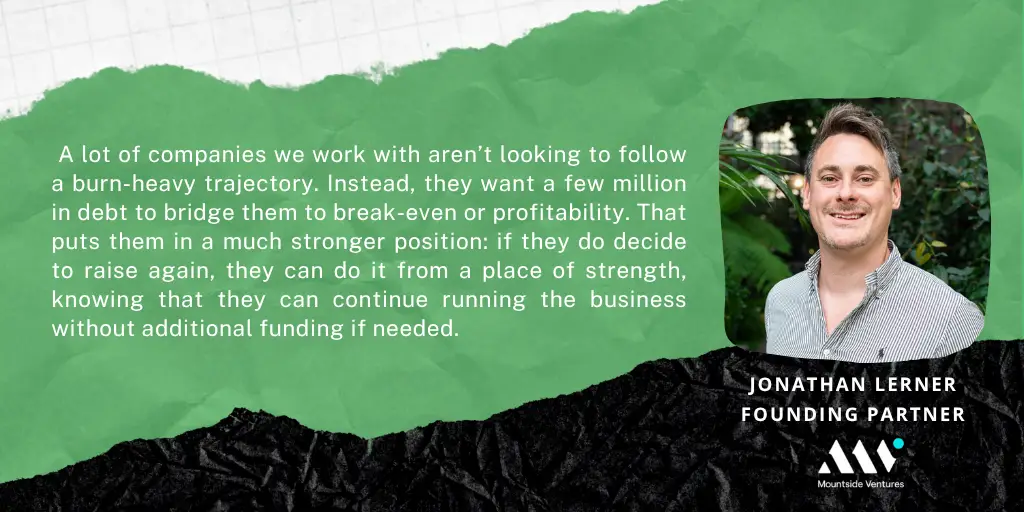
Venture capital, in contrast, is becoming even more concentrated. The capital is flowing into a smaller number of companies, the ones at the very tip of the iceberg, chasing massive exit outcomes. If you look at a fund like Atomico’s latest, they now need to regularly back companies capable of $5 to $10 billion exits, rather than the $500 million to $1 billion outcomes that used to be more common.
But beneath that tip of the iceberg is a much larger base of excellent, innovative companies, the kinds of businesses that could exit for $100 million, $250 million, even $500 million. Those often aren’t attractive to traditional VC anymore, which creates space for more flexible and alternative funding solutions. Even high street banks are entering the conversation now. They’re willing to take on risks they wouldn’t have touched four years ago, because they recognise the opportunity to compete in this space. We’re seeing more flexible debt solutions being offered, no board seats, fewer veto rights, and even capital repayment holidays. Some founders are securing 12- to 18-month interest-only periods, giving them time to deploy capital, reach profitability, and only then begin repayments. For many founders, that’s a much more attractive path than raising a flat equity round or accepting only a marginal uplift, especially if they haven’t hit the growth metrics needed for a competitive Series B.
With venture debt, how much of the decision-making is art and how much is science? What metrics are lenders really looking for?
If I were to apply my earlier analogy, I’d say it’s probably 10 percent art and 90 percent science. It’s far more numbers-driven than equity fundraising.
When we support companies with venture debt, we build what we call “banking case” financial models. While a VC model is based on an optimistic growth scenario, essentially, if everything goes right, here’s how big this can get, a venture debt model is much more conservative. It asks, even if things don’t go perfectly, can we still repay the debt?
So it’s less about projecting 100 percent year-on-year growth and more about showing sustainable 20 to 30 percent growth. The key is demonstrating that the company has enough stability, cash flow visibility, and capital discipline to service the debt over time, even in a more modest growth scenario.
During a fundraise, are there any signals that tell you when a VC is genuinely interested and, on the flip side, when it’s time to cut your losses and move on?
Definitely. One of the clearest buying signals is when an investor starts chasing you for example, WhatsApping to check in on where things stand in the process. Or when they say something like, “I want to run this past investment committee, but one of my partners is on holiday, should I wait or push it through now?” That kind of urgency is a really positive sign. It shows they’re already emotionally invested and trying to figure out how to make the deal work.
Personally, I also pay attention to the types of questions investors ask. I have a mental checklist; are they asking questions that genuinely matter to their decision-making, or just filler? If they’re asking thoughtful, high-signal questions that suggest they’re building conviction, that’s encouraging. But if you’re getting rounds of questions that don’t meaningfully move the needle, then they’re probably not serious. In those cases, they’re likely just trying to build the relationship for a future round, not this one. Knowing when to walk away saves everyone time.
You’ve worked with a lot of CFOs after they’ve helped take a business through Series A or B. In your eyes, what makes a truly great CFO in a scaling company?
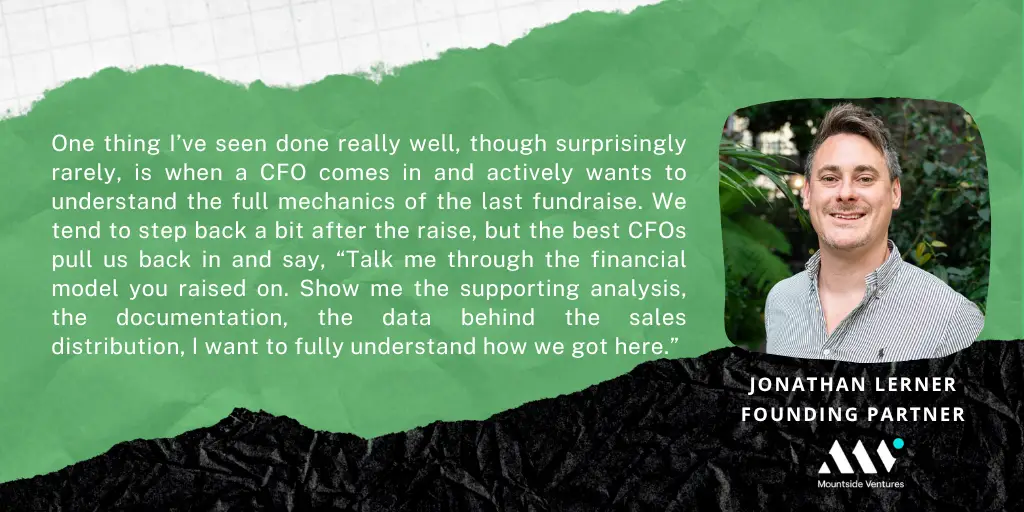
That drive to internalise the fundraise rationale and methodology, and to keep those insights alive post-raise, is incredibly valuable. Most of the time, companies archive everything and only dust it off when it’s time to raise again. But a great CFO uses that foundation to build ongoing reporting and strategy.
This is especially important because, in many cases, the CFO joins after the Series A, they’re part of the use-of-funds plan. So it’s critical they understand why investors backed the company. Not just what the company does or what metrics to track in a general sense, but why this company was funded, what narrative and data convinced investors, and how to keep delivering against that. To me, that’s the difference between someone who holds the CFO title and someone who is a true CFO.
AI is getting a lot of attention, but when you look at where capital is actually flowing, what sectors or types of businesses are genuinely gaining traction right now?
I’ll go slightly against the grain on this. There has been a lot of talk about agentic AI solutions and autonomous agents solving business problems, but what that really translates to, in most cases, is an evolution of B2B SaaS. B2B SaaS has always been the core of the VC market, and I’d say that has not changed. If you’re a B2B SaaS company right now, what matters most is showing how you are using off-the-shelf AI to enhance what you are already doing. And if you can do that convincingly, improving gross margins, shortening onboarding timelines, or reducing headcount through automation, you can still raise a very competitive round.
We are working with several companies right now that are doing exactly this. They have raised strong Series A rounds with just £1–2 million in ARR by showing how they have embedded AI into their operations. The emphasis is on applied AI, not building foundational models, which is still incredibly capital intensive and only really being done by a handful of players. Most VCs here are not backing foundational model plays. The capital required is just too high. Instead, the opportunity lies in leveraging those models - OpenAI, Claude, Mistral - to enhance your own product and operations. If you can do that, particularly through conversational AI interfaces that improve enterprise workflows, you are still in a good position in this market.
Beyond AI, we have seen a bit of a cooling in fintech investment. I think that is because many of the more interesting fintech founders are now tackling broader horizontal problems, not just solutions for the financial sector. Cybersecurity, on the other hand, is heating up quickly. It has a strong overlap with defence tech, which is drawing a lot of interest, but not everyone wants to be seen directly investing in weapons or military applications. Cybersecurity provides a more comfortable entry point. It is still mission critical, still defence adjacent, and aligns with broader geopolitical concerns, but it is an easier story to tell from a positioning perspective.
Finally, if you could give one piece of advice to a founder running a Series A or Series B business, what would it be?
Don’t drip-feed a fundraise. One of the biggest tips I give founders is this: when you're focused on product, sales, and implementation, and an investor reaches out, let them know you’re heads-down for now but appreciate their interest. Share some generic, non-financial information they can use to familiarise themselves with the business, and then add them into a tracker or pipeline. That way, when you're actually ready to raise, you can go back to all of those contacts at the same time and run a structured process.
It’s really difficult to manufacture momentum if you’re speaking to VCs in a staggered way. Back-to-back investor calls and due diligence conversations are hard, but they’re incredibly valuable. I see too many founders fall into the trap of drip-feeding information, and then suddenly an investor gets excited, offers a term sheet and the founder panics because no one else is at the same stage.
At that point, the VC controls the process, the timeline, and the terms, because they’re the only one at the table. The founder has lost all competitive tension.
Thank you Jon, it has been great diving into your world today!

